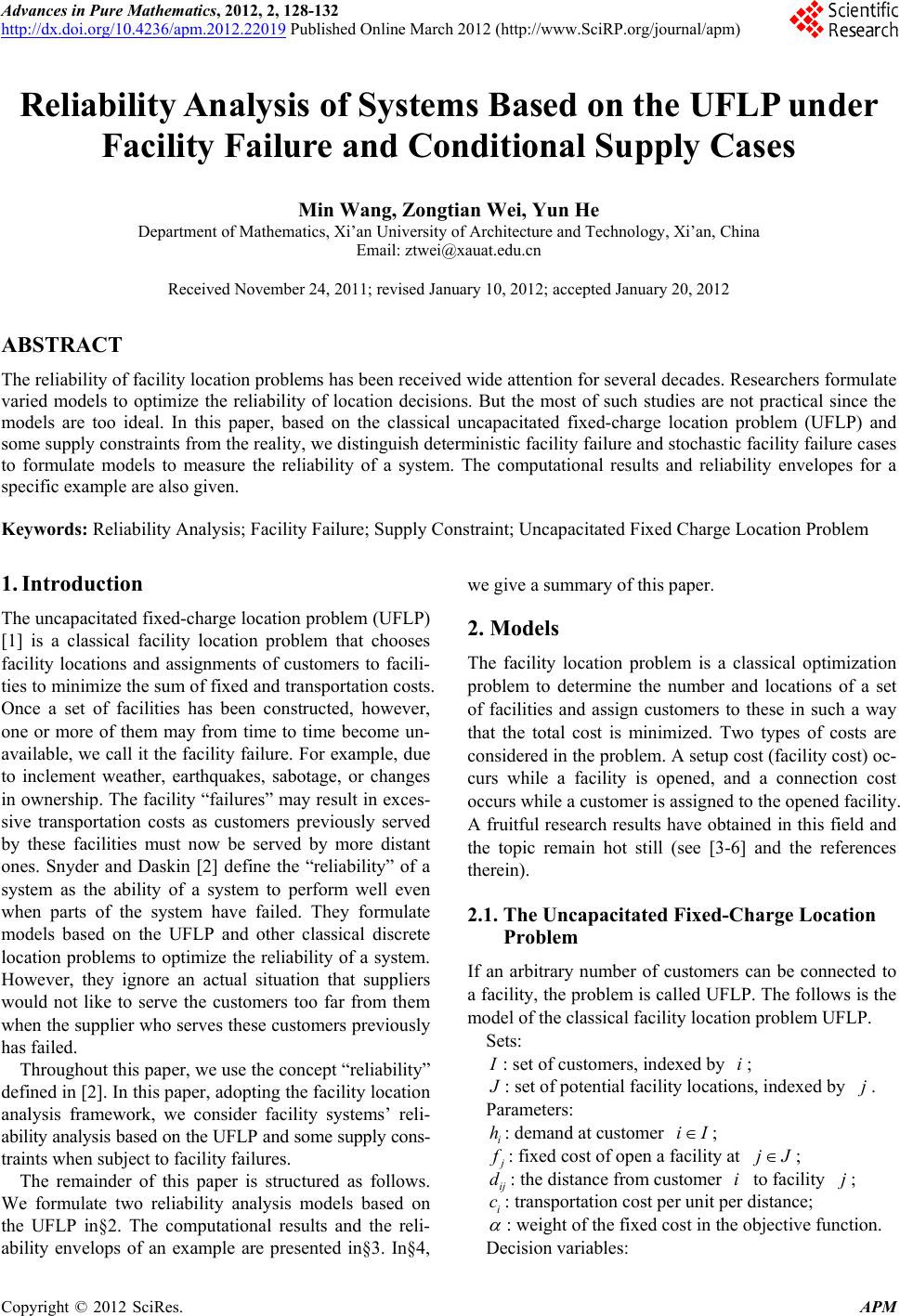
Advances in Pure Mathematics, 2012, 2, 128-132
http://dx.doi.org/10.4236/apm.2012.22019 Published Online March 2012 (http://www.SciRP.org/journal/apm)
Reliability Analysis of Systems Based on the UFLP under
Facility Failure and Conditional Supply Cases
Min Wang, Zongtian Wei, Yun He
Department of Mathematics, Xi’an University of Architecture and Technology, Xi’an, China
Email: ztwei@xauat.edu.cn
Received November 24, 2011; revised January 10, 2012; accepted January 20, 2012
ABSTRACT
The reliability of facility location problems has been received wide attention for several decades. Researchers formulate
varied models to optimize the reliability of location decisions. But the most of such studies are not practical since the
models are too ideal. In this paper, based on the classical uncapacitated fixed-charge location problem (UFLP) and
some supply constraints from the reality, we distinguish deterministic facility failure and stochastic facility failure cases
to formulate models to measure the reliability of a system. The computational results and reliability envelopes for a
specific example are also given.
Keywords: Reliability Analysis; Facility Failure; Supply Constraint; Uncap acitated Fixed Charge Location Problem
1. Introduction
The uncapacitated fixed-ch arge location problem (UFLP)
[1] is a classical facility location problem that chooses
facility locations and assignments of customers to facili-
ties to minimize th e sum of fixed and transpor tation costs.
Once a set of facilities has been constructed, however,
one or more of them may from time to time become un-
available, we call it the facility failure. For ex ample, due
to inclement weather, earthquakes, sabotage, or changes
in ownership. The facility “failures” may result in exces-
sive transportation costs as customers previously served
by these facilities must now be served by more distant
ones. Snyder and Daskin [2] define the “reliability” of a
system as the ability of a system to perform well even
when parts of the system have failed. They formulate
models based on the UFLP and other classical discrete
location problems to optimize the reliability of a system.
However, they ignore an actual situation that suppliers
would not like to serve the customers too far from them
when the supplier who serves these customers previously
has failed.
Throughout this pa per, we use the concept “reliab ility”
defined in [2]. In this paper, ad opting th e facility locatio n
analysis framework, we consider facility systems’ reli-
ability analysis based on the UFLP and some supply cons-
traints when subject to facility failu res.
The remainder of this paper is structured as follows.
We formulate two reliability analysis models based on
the UFLP in§2. The computational results and the reli-
ability envelops of an example are presented in§3. In§4,
we give a summary of this paper.
2. Models
The facility location problem is a classical optimization
problem to determine the number and locations of a set
of facilities and assign customers to these in such a way
that the total cost is minimized. Two types of costs are
considered in the problem. A setup cost (facility cost) oc-
curs while a facility is opened, and a connection cost
occurs while a customer is assigned to the opened facility.
A fruitful research results have obtained in this field and
the topic remain hot still (see [3-6] and the references
therein).
2.1. The Uncapacitated Fixed-Charge Location
Problem
If an arbitrary number of customers can be connected to
a facility, the problem is called UFLP. The follows is th e
model of the classical facility location problem UFLP.
Sets:
: set of customers, indexed by ; i
: set of potential facility locations, indexed by . j
i
hiI
Parameters:
: demand at customer ;
: fixed cost of open a facility at ;
jJ
ij
dij
i
c: the distance from customer to facility ;
: transportation cost per un it per distance;
: weight of the fixed cost in the objective function.
Decision variables:
C
opyright © 2012 SciRes. APM